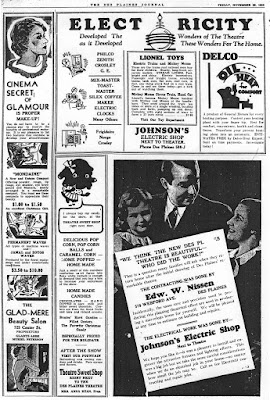This piece was originally published at Des Plaines Patch. This version features exclusive images.
I think Des Plaines has a lot of interesting architecture. The Des Plaines Theatre is at the top of that list for me, and I don't think I'm alone. It's a very unique theatre, a direct expression of the "Roaring Twenties," probably our most identifiable landmark, and quite possibly our most interesting public interior space, which is just now being revealed again.
I think Des Plaines has a lot of interesting architecture. The Des Plaines Theatre is at the top of that list for me, and I don't think I'm alone. It's a very unique theatre, a direct expression of the "Roaring Twenties," probably our most identifiable landmark, and quite possibly our most interesting public interior space, which is just now being revealed again.
In August, Revitalize Des Plaines! marked the 85th anniversary of the theatre's opening day with a look back at how excited the community was at the theatre's opening. August 9, 1925 was a pivotal day in Des Plaines' transition from a small village to a modern city.
Today, our community is once again buzzing about the Des Plaines Theatre, as its long-awaited renovation kicked off on Saturday, October 23rd. In that light, let's look back at the theatre's first major renovation.
The Des Plaines Theatre thrived after its opening in 1925, even though its 3 Manual Geneva Organ wasn't completed until December. It showed movies and short features continuously Monday-Friday from 7 p.m. to 11 p.m; on Saturdays and Sundays it opened at 2 p.m. for a matinee, and Sundays added five acts of Vaudeville with a six-piece orchestra. The Polka Brothers even had an annual indoor circus, featuring all the big acts - including elephants.
In addition to the population of downtown Des Plaines, the elaborate new theatre was the showplace of the Northwest suburbs and attracted visitors from miles around. It inspired the owners of the older Echo theatre on Lee Street - now the downtown post office branch - to rebuild much of their theatre - although it ultimately proved no competition. Its success inspired the Polka Brothers to build a new, even bigger and more elaborate theatre in 1927 - Park Ridge's Pickwick. After that, the Des Plaines would play second fiddle.
"Talking pictures" hit Des Plaines for the first time on April 24, 1929, with George M. Cohan in The Hometowners. But the stage shows and organ playing went on for a few more years.
The Great Depression hit hard, though. In 1931 the Polka Brothers closed the theatre for the summer, encouraging patrons to go to the Pickwick. Later that year, after it reopened, the notorious projectionists' union headed by racketeer Tommy Maloy tried to force all theatres to employ two projectionists; 104 theatres locked their doors in protest. The Polka Brothers defied Maloy by personally operating the projection in their theatres. Labor troubles continued.
On July 23, 1932, bombs went off behind the Pickwick and Des Plaines. The theatres suffered minimal damage, but the adjacent houses found themselves missing a few windows. The Polka Brothers soon threw in the towel and several headed back to their resort in Germany. In August 1934 the organ and sound equipment were sold off to help pay off the Polka's defaulted mortgage. In February, 1935 one of the biggest stars to grace the Des Plaines' stage would appear - Gene Autry.
It was time to make a big splash - something that would make the whole city "sit up and take notice". In July, the big announcement came - the Theatre was to be taken over by Chicago's H&E Balaban chain, an offshoot of the biggest theatre operator in Chicagoland, Balaban & Katz. They announced a total overhaul - new seats, new screen, projection and sound equipment, redecorating inside and an all new entrance. It would all be planned by art deco architects Pereira & Pereira, who would go on to create Chicago's Esquire Theatre and San Francisco's Transamerica Pyramid.
The entryway was covered in ultra-modern black Vitrolite glass with stainless steel trim and a new sidewalk box office. The lobby was transformed into a "garden" lounge, with its box office removed, walls plastered over and redecorated in soft blending colors, tile floors covered in carpet, and comfortable seating added. The new "strato" foyer recieved new bathrooms and more lounge pieces. Inside the auditorium, the walls were repainted in muted blue and gray, and some "old-fashioned" ornament was removed. And to the relief of patrons, an air conditioning system was added the following spring. Ads proclaimed "A NEW MODE IN THEATER BEAUTY... PERFECTION IN LIGHTING, DECORATION, AND COMFORT".
But the biggest change was the signature marquee: a massive art deco sculpture covered in dazzling neon and flashing lights, with the newest technology - backlit Adler silhouette letters to spell out the movie titles. The White Way marquee would light up downtown at night, more than the streetlights ever did, and become the most instantly identifiable element of downtown Des Plaines.
The reborn theatre held its grand reopening on November 29, 1935 with the stars of WLS' Barn Dance on stage and the film Annapolis Farewell.
 |
| The art deco lobby as it appeared in Box Office Magazine in 1947. Courtesy Theatre Historical Society of America |
Seventy-five years later - almost to the day - the theatre stands poised for its next rebirth. The transformation is taking place at the same dizzying pace. It won't be as polished as it was then, but I think seeing the auditorium in one piece again for the first time in 23 years will be just as dazzling.
EXCLUSIVE: Reopening Program







